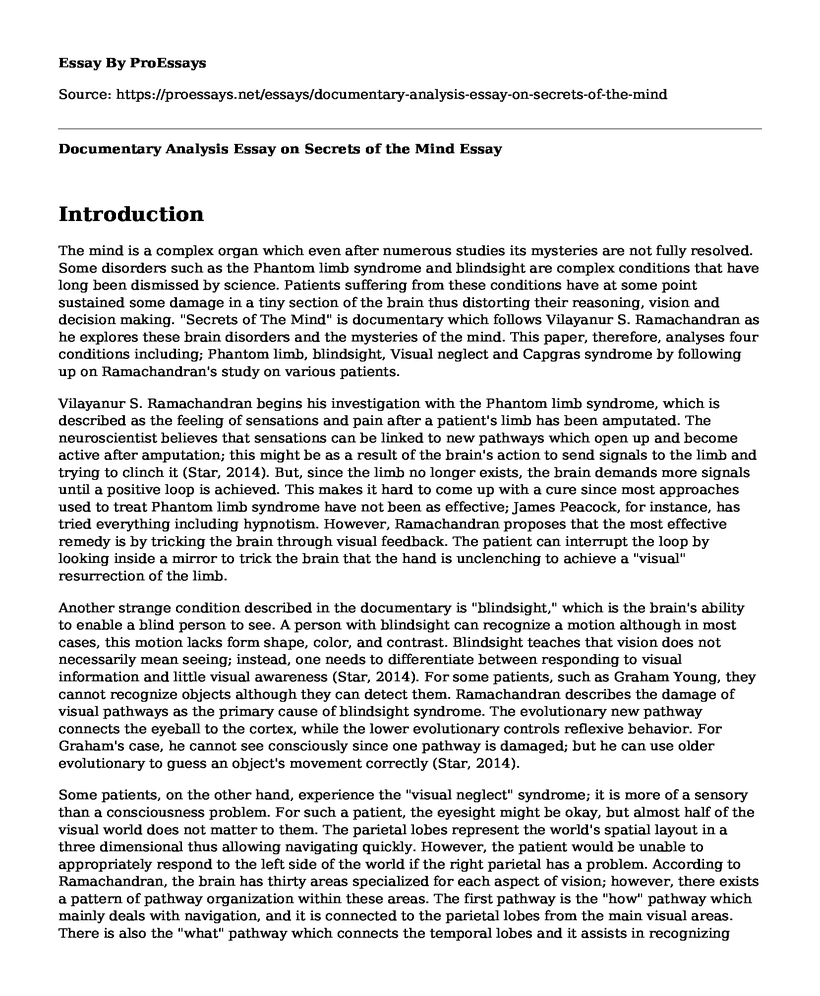Introduction
The mind is a complex organ which even after numerous studies its mysteries are not fully resolved. Some disorders such as the Phantom limb syndrome and blindsight are complex conditions that have long been dismissed by science. Patients suffering from these conditions have at some point sustained some damage in a tiny section of the brain thus distorting their reasoning, vision and decision making. "Secrets of The Mind" is documentary which follows Vilayanur S. Ramachandran as he explores these brain disorders and the mysteries of the mind. This paper, therefore, analyses four conditions including; Phantom limb, blindsight, Visual neglect and Capgras syndrome by following up on Ramachandran's study on various patients.
Vilayanur S. Ramachandran begins his investigation with the Phantom limb syndrome, which is described as the feeling of sensations and pain after a patient's limb has been amputated. The neuroscientist believes that sensations can be linked to new pathways which open up and become active after amputation; this might be as a result of the brain's action to send signals to the limb and trying to clinch it (Star, 2014). But, since the limb no longer exists, the brain demands more signals until a positive loop is achieved. This makes it hard to come up with a cure since most approaches used to treat Phantom limb syndrome have not been as effective; James Peacock, for instance, has tried everything including hypnotism. However, Ramachandran proposes that the most effective remedy is by tricking the brain through visual feedback. The patient can interrupt the loop by looking inside a mirror to trick the brain that the hand is unclenching to achieve a "visual" resurrection of the limb.
Another strange condition described in the documentary is "blindsight," which is the brain's ability to enable a blind person to see. A person with blindsight can recognize a motion although in most cases, this motion lacks form shape, color, and contrast. Blindsight teaches that vision does not necessarily mean seeing; instead, one needs to differentiate between responding to visual information and little visual awareness (Star, 2014). For some patients, such as Graham Young, they cannot recognize objects although they can detect them. Ramachandran describes the damage of visual pathways as the primary cause of blindsight syndrome. The evolutionary new pathway connects the eyeball to the cortex, while the lower evolutionary controls reflexive behavior. For Graham's case, he cannot see consciously since one pathway is damaged; but he can use older evolutionary to guess an object's movement correctly (Star, 2014).
Some patients, on the other hand, experience the "visual neglect" syndrome; it is more of a sensory than a consciousness problem. For such a patient, the eyesight might be okay, but almost half of the visual world does not matter to them. The parietal lobes represent the world's spatial layout in a three dimensional thus allowing navigating quickly. However, the patient would be unable to appropriately respond to the left side of the world if the right parietal has a problem. According to Ramachandran, the brain has thirty areas specialized for each aspect of vision; however, there exists a pattern of pathway organization within these areas. The first pathway is the "how" pathway which mainly deals with navigation, and it is connected to the parietal lobes from the main visual areas. There is also the "what" pathway which connects the temporal lobes and it assists in recognizing objects (Star, 2014). If one of the pathways is damaged, maybe from an accident, the patient is most likely to suffer from visual neglect or Capgras Delusion.
For patients suffering from Capgras Delusion syndrome, visual process is always taking place in the wrong part of the brain. Seeing, as described by Ramachandran, is a multi-level process; when one looks at an object, the temporal lobes receive the message which gets relayed through amygdala to evoke an emotional response (Star, 2014). But, if one gets into an accident and the fiber connecting amygdale is destroyed, the patient experience difficulty in generating the appropriate emotional response. For a patient such as David Silvera, messages get to the temporal lobe cortex, and he can recognize his father. However, due to the accident, the fibers leading to emotional centers are cut; the message fails to reach the amygdala making it impossible for him to have emotions. According to Ramachandran, David might not be emotionally disturbed or psychotic although it seems so. He is an example of a patient with profound delusion. His lack of emotional response indicates the importance of emotions to the recognition process of the brain.
Conclusion
In conclusion, for centuries, brain disorders such as the Phantom limb syndrome and blindsight have been dismayed by scientists. However, through "Secrets of The Mind," Vilayanur S. Ramachandran analyses some of these disorders including Phantom limb syndrome, blindsight, visual neglect and Capgras Delusion syndrome, by carefully studying his patients. The documentary explains the different parts of the brain which lead to the various conditions and the best way of addressing these disorders.
Reference
Star Stuff. (2014, Dec 2). Secrets of the Mind Nova HD [Video file]. Retrieved from https://www.youtube.com/watch?v=w6AfzCNDmbY&t=41s
Cite this page
Documentary Analysis Essay on Secrets of the Mind. (2022, Jun 26). Retrieved from https://proessays.net/essays/documentary-analysis-essay-on-secrets-of-the-mind
If you are the original author of this essay and no longer wish to have it published on the ProEssays website, please click below to request its removal:
- Anxiety Disorders
- Essay Example on White-Collar Crime and Deviance
- Essay Sample on Little Hans' Phobia: Freud's Oedipus Complex Study
- Essay on Connection Between Culture, Subculture, & Film: Exploring the Relationship
- Essay Example on Israeli Films: Mirrors of History & Creative Contexts
- Essay Example on Growing Older: How Healthcare is Adapting to an Aging Population
- Architectural Innovations: The Local Nomad Shop in Phoenix, Arizona - Free Paper Sample







